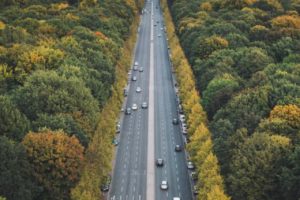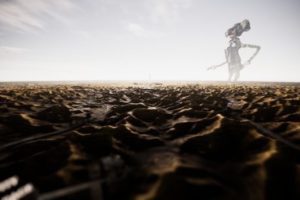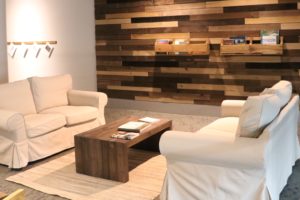Associate Curator, Anthropocene Studies

Biography
Nicole Heller is Associate Curator of Anthropocene Studies for Carnegie Museum of Natural History. She is a transdisciplinary professional focused on improving cultural and ecological sustainability. Heller received her Ph.D. from Stanford University in Biological Sciences in 2005, and a B.A. from Princeton University in Ecology and Evolutionary Biology in 1995. She conducted postdoctoral research in the Environmental Studies Department at University of California, Santa Cruz.
Heller’s primary research is concerned with understanding and promoting biological diversity in the face of global changes associated with the Anthropocene. Heller’s dissertation research focused on the ecology of a globally dispersed ant: the Argentine ant. Her work shed light on their social organization and interactions with climate and human systems, and how these factors combine to determine the ants’ rate of spread and impact.
For the last 15 years, Heller has been working at the intersection of research and practice to pioneer climate change adaptation and resilience. Her research has produced novel theory for organizing natural resource management for better success in the 21st century. The work describes a rationale for reconfiguring management goals from species composition endpoints toward sustainable, ethical relationships among humans and other living beings. To bring theory into practice, she has worked with practitioners to develop conservation projects, planning and stewardship tools designed to better accommodate people and diverse cultural knowledge, global changes, as well as the inherent resilience and autonomy of other living beings. Her research has been published in academic and popular presses.
Heller is an affiliated researcher with the Terrestrial Biodiversity and Climate Change Collaborative, Resilient Silicon Valley, Switzer Foundation, and the Amah Mutsun Land Trust. Prior to joining Carnegie Museum of Natural History, Heller served as the Director of Conservation Science at Peninsula Open Space Trust; the Climate Adaptation Scientist at Pepperwood’s Dwight Center for Conservation Science; and a Research Scientist at Climate Central. She has also held Visiting Assistant Professor appointments at Duke University and Franklin & Marshall College.
Heller’s secondary focus of research and practice is about creative, effective environmental communication. She was awarded a Google Science Communication Fellowship for this work. At the science and news organization Climate Central, Heller was the lead scientist on a variety of climate-change media investigations, which included a series aired on the PBS NewsHour. At Duke University, Heller directed an Art and Science Initiative that included curating an art exhibit “Re-imagining Nature”; this doubled as a psychology laboratory to experiment with how message-framing and imagery influenced people’s memory and engagement with the exhibition. In addition, Heller has collaborated with artists in variety of projects that seek to instigate social change. This work has been supported by Invoking the Pause. At the museum, Heller is collaborating with designers, learning scientists, artists, and anthropologists to develop participatory, empowering informal science education and community engagements for grappling with and responding to the challenge of the Anthropocene.
Publications
Stanford, B., K. Ikyanan, R. Grossinger, E. Beller, M. Benjamin, J. L. Grenier, M. Bazo, N. Heller, M. Aronson, A. Felson, P. Groffman, and E. Spotswood (2023). Making Nature’s City: An Applied Science Framework to Guide Evaluation and Planning for Urban Biodiversity Conservation, in Urban Biodiversity and Equity: Just-centered conservation in cities (M. Lambert and C. Schell, eds.), Oxford Press, Oxford.
Steiner, M.A., K. Knutson, K. Crowley, N. Heller, B. McGill, L. Giarratani, J. Russell & T. Nelson 2023. Taking time to listen and learn: a museum partnership designed to engage rural audiences in climate change conversations, Museums & Social Issues, DOI: 10.1080/15596893.2023.2263528
Heller, N.E. 2023. Perspective: Is re-interpretation enough? Dismantling violence in the natural history museum. Curator The Museum Journal, 66: 483-491.
Heller, N.E., K. McManus-Chauvin, D. Skybrook, and A.D. Barnosky. 2023. Including stewardship in ecosystem health assessment. Nature Sustainability, https://www.nature.com/articles/s41893-023-01096-7
McLaughlin, B.C., S.A Skikne, E. Beller, R.V. Blakey, R.L. Olliff-Yang, N. Morueta-Holme, N.E. Heller, B.J. Brown, and E.S. Zavaleta. 2022. Conservation strategies for the climate crisis: An update on three decades of biodiversity management recommendations from science. Biological Conservation 268, April. https://doi.org/10.1016/j.biocon.2022.109497
Couper, L.I., N.J. Sanders, N.E. Heller, and D.M. Gordon. 2021. Multiyear drought exacerbates long-term effects of climate on an invasive ant species. Ecology https://doi.org/10.1002/ecy.3476
Heller, N.E. 2021. Museums Facing Climate Change. All Hands on Deck: Moving Past Climate Science and into Culture. In “Stemming the Tide: Global Strategies for Sustaining Cultural Heritage through Climate Change” edited by R.A. Rushfield. Smithsonian Scholarly Press. https://doi.org/10.5479/si.14750727
EN Spotswood, EE Beller, R Grossinger, JL Grenier, NE Heller, and MF Aronson. 2021. The Biological Deserts Fallacy: Cities in Their Landscapes Contribute More than We Think to Regional Biodiversity. BioScience, biaa155, https://doi.org/10.1093/biosci/biaa155
Oliveira, G, E. Dorfman, N. Kramar, C.D. Mendenhall, and N.E. Heller. 2020. The Anthropocene in natural history museums: A productive lens of engagement. Curator, 63(3): 333-351.
Heller, N. and T. Matza. 2020. “The Surrounding Trees Whispered with Their Leaves.” In “Post-Covid Fantasies,” Catherine Besteman, Heath Cabot, and Barak Kalir, editors, American Ethnologist website, 19 October 2020, [https://americanethnologist.org/features/pandemic-diaries/post-covid-fantasies/the-surrounding-trees-whispered-with-their-leaves]
Heller, N.E. 2020. Ants in Space. In “Space: A History”, edited by Andrew Janiak. Oxford Philosophical Concepts, Oxford University Press, Oxford.
Keeley, A., Basson, G., Cameron, D.R., Heller, N.E, Huber, P., Schloss, C., Thorne, J. and Merenlender, A. (2018). Making habitat connectivity a reality. Conservation Biology. 10.1111/cobi.13158.
Annika T H Keeley, David D Ackerly, D Richard Cameron, Nicole E Heller, Patrick R Huber, Carrie A Schloss, James H Thorne and Adina M Merenlender. 2018. New concepts, models, and assessments of climate-wise connectivity. Environmental Research Letters: 13 (7)
NE Heller and TA Matza, Anthropocene in a Jar, Future Remains: A cabinet of curiosities for the anthropocene edited by G. Mittman, M. Armireo, and R. Emmet. University of Chicago Press, 2018
Chiew, K. J Hashemi, LK Gans, L Lerebours, NJ Clement, MT Vu, G Sapiro, NE. Heller, and RA Adcock. Motivational context and individual differences influence exploration and learning of a real-life spatial environment. PlosOne 13(3): e0193506.
Heller, NE, J Krietler, DA Ackerly, SB Weiss, A Recinos, R Branciforte, LE Flint, AL Flint and LE Micheli (2015). Targeting climate diversity in conservation planning to build resilience to climate change. Ecosphere 64: 65
Lawler, J, D Ackerly, C Albano, M Anderson, M Cross, S Dobrowski, J Gill, NE Heller, R Pressey, E Sanderson, and S Weiss. (2015). The theory behind, and challenges of, conserving nature’s stage in a time of rapid change. Conservation Biology 29: 618-629
Comer, PJ, RL Pressey, ML Hunter, Jr, C Schloss, S Buttrick, NE Heller, J Tirpak, DP Faith, M Cross, and M Shaffer (2015). Incorporating geodiversity into conservation decisions. Conservation Biology 29: 692-701
Chornesky, EA, DD Ackerly, P Beier, FW Davis, LE Flint, JJ Lawler, PB Moyle, MA Mortiz, M Scoonover, P Alvarez, K Byrd, NE Heller, ER Micheli, and SB Weiss (2015). Adapting California’s Ecosystems to a Changing Climate. Bioscience 65: 247-262
Heller, NE and RJ Hobbs (2014) Development of a natural practice to adapt conservation goals to global change. Conservation Biology 28: 696 – 704
Martin L, JE Quinn, EC Ellis, MR Shaw, MA Dorning, LM Hallett, NE Heller, RJ Hobbs, CE Kraft, E Law, NL Michel, M Perring, PD Shirey, and R Wiederholt (2014). Conservation Opportunities Across the World’s Anthromes. Diversity and Distributions 20: 745 – 755
Safford, H, G Hayward, NE Heller and J Wiens (2012) Historical Ecology, Climate Change, and Resource Management: Can the past still inform the future?, in Historical Environmental Variation in Conservation and Natural Resource Management, Wiley-Blackwell
Shackelford, N, RJ Hobbs, NE Heller, L Hallett and T Seastedt (2013). Finding a middle-ground: the native/non-native debate, Biological Conservation 158: 55–62
Gordon, DM and NE Heller (2013) The invasive Argentine ant Linepithema humile (Hymenoptera: Formicidae) in Northern California reserves: from foraging behavior to local spread. Myrmecological News 19: 103 – 110.
Fitzgerald, K, NE Heller, and DM Gordon (2012) Modeling the spread of the Argentine ant into natural areas: Habitat suitability and spread from neighboring sites. Ecological Modelling 247: 262 – 272
Gordon, DM and NE Heller. (2012) Seeing the forest and the trees: a commentary on supercolonies. Behavioral Ecology and Sociobiology 23 (5): 934-934
Mastrandrea, MD, NE Heller, TL Root, and SH Schneider (2010) Bridging the gap: Linking climate-impacts research with adaptation planning and management, Climatic Change 100:87–101
Heller, NE and ES Zavaleta (2009) Biodiversity management in the face of climate change: a review of 22 years of recommendations. Biological Conservation 142: 14 – 32
Zavaleta ES and NE Heller (2009) Responses of Communities and Ecosystems to Global Changes, in The Princeton Guide to Ecology. Eds Simon Levin et al., Princeton University Press.
Heller, NE, JW Shors, NJ Sanders, and DM Gordon (2008) Rainfall facilitates the spread, and time alters the impact, of the Invasive Argentine Ant. Oecologia 155: 385 – 395
Heller, NE, KK Ingram, and DM Gordon (2008) Nest connectivity and colony structure in unicolonial Argentine Ants. Insectes Sociaux 55, 397 – 403.
Chan, KAM, RM Pringle, J Ranganathan, C Boggs, I Chan, P Ehrlich, NE Heller, D MacMynowski, K Al-Khafaji (2007). When Agendas Collide: Human welfare and conservation goals. Conservation Biology 21:59 – 68
Heller, NE and DM Gordon (2006). Seasonal spatial dynamics and causes of nest movement in colonies of the invasive Argentine Ant (Linepithema humile). Ecological Entomology 31: 499 – 510
Heller, NE, NJ Sanders NJ, and DM Gordon (2006). Linking spatial and temporal scales in a study of an Argentine Ant invasion. Biological Invasions 8: 501- 507.
Heller, NE (2004). Colony structure in introduced and native populations of the invasive Argentine Ant, Linepithema humile. Insectes Sociaux 51: 378 – 386.
Sanders, NJ, NJ Gotelli, NE Heller, and DM Gordon (2003) Community disassembly by an invasive ant species. Proceedings of the National Academy of Sciences 100: 2474 – 2477.
REVIEWS, WHITE PAPERS
Santa Clara Valley Open Space Authority and Conservation Biology Institute. 2017. Coyote Valley Landscape Linkage: A Vision for a Resilient, Multi-benefit Landscape. Santa Clara Valley Open Space Authority, San José, CA. 74p
Heller NE (2009) Pitfalls and Promises of Species Distribution Modeling for Predicting Future Invasions. California Invasive Plant Council Symposium Proceedings, Vol 13, 2009
Heller NE (2009) Book Review: Invasive Species Management: A handbook of principles and techniques. Myrmecological News 13
Bloomfield J., S. Hamburg, N. Heller, A. May, J. Obra, S. Showell (1997) Seasons of Change: Global Warming and New England’s White Mountains. Environmental Defense Fund.
Curation
Re-Imagining the Environment, Wegner Art Gallery, Duke University (2014)
SELECTED BLOGS

New Anthropocene Publication: Stemming the Tide
by Nicole Heller I am pleased to share this Smithsonian Scholarly Press publication, Stemming the Tide: Global Strategies for Sustaining Cultural Heritage Through …
Cities are Not Biological Deserts
by Nicole Heller Cities are increasingly important in organizing the experience of people and their interactions with nature. In 1950 there were …
New Anthropocene Studies Paper in Curator: The Museum Journal
A recent paper in Curator: The Museum Journal sheds light on the particular and growing relevance of natural history museums in sharing …
The Surrounding Trees Whispered with Their Leaves
A fictional short story about a new era of inter-being communication and earth healing from past human mistakes. As a transdisciplinary scholar, …
The inequity of summer heat
Ah, summertime! In Pittsburgh, after months of cold, grey days, the warm temperatures and sunshine bring a collective sigh of relief. Plants …
I love this interspecies friendship!
I confess I am not big on social media, but occasionally I see something that I can’t stop watching. This short clip …
Buried histories, alternative histories, toward a clean and just future
As part of ongoing Anthropocene engagement at the Carnegie Museum of Natural History, we aim to support transdisciplinary conversations about urgent issues …
Anthropocene Living Room
Welcome to the Anthropocene Living Room, a new space in the museum inspired by how humans have and will continue to shape …
Migrate or Die
By Dr. Nicole Heller Becoming Migrant was this year’s theme for the Carnegie Nexus. The series explored the science and art of …









